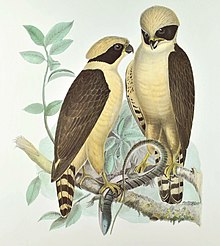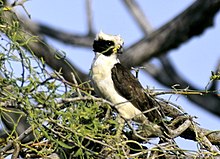Laughing hawk
| Laughing hawk | ||||||||||||
|---|---|---|---|---|---|---|---|---|---|---|---|---|

Laughing falcon ( Herpetotheres cachinnans ) |
||||||||||||
| Systematics | ||||||||||||
|
||||||||||||
| Scientific name of the genus | ||||||||||||
| Herpetotheres | ||||||||||||
| Vieillot , 1817 | ||||||||||||
| Scientific name of the species | ||||||||||||
| Herpetotheres cachinnans | ||||||||||||
| ( Linnaeus , 1758) |

The laughing falcon ( Herpetotheres cachinnans ) or laughing hawk is a species of bird in the falcon-like family .
features
The laughing falcon can grow to between 46 and 56 centimeters. The females are usually larger than the males and weigh 600 to 800 grams, the males reach a weight of 410 to 680 grams. Its plumage is white to ocher, the wings are dark brown. It is unmistakable through its black face mask that looks like glasses. The tail is striped black and white, the legs are red and orange in color. On the head there is a yellowish, light gray striped cap; this can be set up. The beak is dark gray, the wax skin is yellow. The laughing falcon has very broad wings.
Way of life
Laughing falcons are solitary animals and only come together during the mating season. Their large eyes indicate that they are mainly crepuscular and nocturnal. They feed on small mammals, reptiles and fish . The main food is snakes , poisonous snakes can also be caught. When a laughing hawk spies a snake, it pounces on it and grabs it right behind the head. The horny scales on the legs and the dense belly plumage protect against bites.
The mating season of the laughing falcon begins in spring. The breeding area is defended against other laughing falcons. The nests are created in rock niches. If suitable nesting opportunities are not available, tree hollows or the abandoned nests of birds of prey are also used. The female lays one or two light, brown-spotted eggs. The eggs are hatched for about 45 days by both sexes. The young birds are nestled, often only the first hatched young survive. The young birds fledge after 55 to 60 days. In captivity, laughing falcons can live to be 12 to 14 years old.
Laughing falcons call “gwa-co” in the morning and at dusk, and two animals can often be heard. These calls gave them the name Guaco in Costa Rica . It got its German name from the loud "ha ha ha" calls.
distribution
Laughing falcons live in open forests or in steppe areas with sparse tree cover. They occur everywhere in South America from northern Argentina to Mexico . In the Andes of Colombia it can sometimes be found at heights of up to 2,400 meters.
Subspecies
The following subspecies are divided:
- H. c. cachinnans
- H. c. chapmani
- H. c. queribundus
Individual evidence
- ↑ El Halcón Guaicurú (Spanish)
- ^ Steve NG Howell and Sophie Webb: A Guide to the Birds of Mexico and Northern Central America. Oxford University Press, 1995 ISBN 0-19-854012-4
literature
- Wilhelm Eigener : Large colored animal lexicon . Georg Westermann Verlag Licensed edition for Manfred Pawlak Verlags GmbH, Herrsching 1982
Web links
- The Hawk Conservancy Trust: Description of laughing falcon (Engl.)
- World Bird Guide: List of audio recordings of the laughing hawk
- Internet Bird Collection: List of video recordings of the laughing hawk
- Herpetotheres cachinnans onthe IUCN 2013 Red List of Threatened Species . Listed by: BirdLife International, 2012. Retrieved November 18, 2013.
